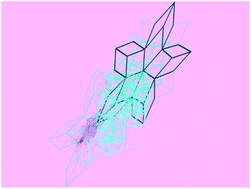Aluminal speciation in the crystal nucleus: a mass spectral interpretation†
Abstract
Mass spectral line positions m/z are computed from a general formula for aluminium cations, AlnOp(OH)q(OH2)r(3n−2p−q)+, without treating n, p, q and r as independent variables but instead constraining parameters by tetrahedral or octahedral symmetry, in accordance with each of a number of structural possibilities. In one instance, a ring is distinguishable from a chain; in another, an orthorhombic sheet from a hexagonal prism. Amongst other polyhedra, five distinct icosahedral cases are discussed. Classical constructions are revisited in the light of aperiodic tiling. Successive Fibonacci numbers may describe the nucleation of a structure previously regarded as amorphous. Recent experimental observations are reviewed in the same context, and re-interpreted. A spectral value may be ascribed to a tetrahedral or an octahedral species (ambiguity is rare). The results may be a significant factor in an understanding of crystal nucleation.


 Please wait while we load your content...
Please wait while we load your content...